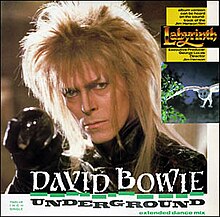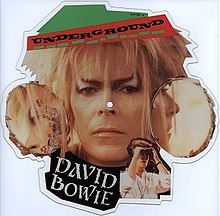Underground (David Bowie song)
| "Underground" | ||||
|---|---|---|---|---|
 | ||||
| Single by David Bowie | ||||
| from the album Labyrinth | ||||
| B-side | "Underground (Instrumental)" | |||
| Released | 9 June 1986[1] | |||
| Recorded | 1985 | |||
| Genre | ||||
| Length | 5:57 (Album version) 4:25 (Edited version) | |||
| Label | EMI EA216 | |||
| Songwriter(s) | David Bowie | |||
| Producer(s) | ||||
| David Bowie singles chronology | ||||
| ||||
| 7" Picture Disc Cover | ||||
 EAP 216 (UK) | ||||
| Music video | ||||
| "Underground" on YouTube | ||||
"Underground" is a song written and recorded by David Bowie for the soundtrack of the 1986 film Labyrinth. It reached No. 21 in the UK Singles Chart.
Details and background
Bowie wrote and recorded five songs for Labyrinth, in which he also starred as Jareth, the king of the goblins.[4] "Underground" is the film's theme song; a slower, re-scored version by composer Trevor Jones plays over the opening credits whilst Bowie's original version plays during the end credits.[5][6] Explaining his choice of musical style for the song, Bowie said: "The film essentially deals with a girl's emotions and what she's going through, discovering about herself and her parents and her relationship to her family. So I wanted something very emotional, and for me the most emotional music I can think of is gospel."[5]
Bowie and producer Arif Mardin recorded "Underground" at Atlantic Studios in New York. The track included a large chorus of backing vocalists including Chaka Khan, Luther Vandross and Daphne Rubin-Vega,[3] along with the Radio Choir of the New Hope Baptist Church.[5]
Lead guitar was played by blues guitarist Albert Collins, whose contribution to the song was described by Bowie as "a very savage, rough, aggressive sound which goes against some of the maybe superficial slickness of the synthesizers."[5]
Video
Steve Barron directed the promotional video clip for the song, which was filmed at Shepperton Studios over two days in 1986.[7] The video portrays Bowie as a nightclub singer who walks into an ominous alleyway where he encounters various puppet creatures from Labyrinth, including characters such as Hoggle and the Junk Lady.[3][8] Bowie turns into a cartoon figure, stepping into an animated underground world. Before his descent there is a brief montage of numerous past images of Bowie, including musical personae from Ziggy Stardust to Jazzin' for Blue Jean and his film characters from The Man Who Fell To Earth and The Hunger.[7][8]
Labyrinth director Jim Henson was impressed enough with Barron's style to offer him a job directing the pilot episode of The Storyteller.[5] Though Bowie was not heavily involved in promoting the film, Henson was nonetheless grateful for the "Underground" video, saying, "I think it's the best thing he could have done for the film."[9][10] Bowie was not happy with the video, saying in 1987, "I've found that the videos I put into other people’s hands have always been a mistake. Because of my lack of interest, I didn't get that involved with things like 'Underground' which I did for Labyrinth. I just left it up, and the result is just not my kind of video. I was a bit lax there. I didn't feel involved."[11][12] Despite Bowie's dislike for the video, Entertainment Weekly and Esquire considered it to be among his best after he died in 2016.[13][14]
According to Screen Rant, the video can be interpreted as "background and lore to Bowie's character" Jareth, showing an origin story "of how he was an ordinary man that wandered into the Underground (the world of Labyrinth), and became the Goblin King."[15]
Reception
Sean Stangland of the Daily Herald described "Underground" as a "pop ballad that climaxes in a gospel celebration."[2] Similarly describing the song as "a joyous rave-up that starts out as synth-pop before transitioning to a gospel barnstormer", David Brusie of The A.V. Club noted that it had a similar production style to Bowie's 1983 Motown-influenced song "Modern Love". Brusie also wrote that "Underground" is "distinctly American-sounding, making for a striking ending" to Labyrinth, as the film's story is "steeped in European influences like Alice In Wonderland and Grimm’s fairy tales."[16]
Smooth Radio chose "Underground" as number 15 on its ranking of Bowie's 20 greatest songs.[17] Newsweek considered it the strongest song on the Labyrinth soundtrack,[18] a view shared by Screen Rant, which considered "Underground" as one of "the 10 best movie theme songs from the 80s".[19]
Follow-up singles
"As the World Falls Down" was considered for a Christmas 1986 single release, but was canceled.[20] "Magic Dance" was released as the second single from the soundtrack to limited countries in January 1987.
Track listing
All tracks by Bowie
7" Commercial Single/12" Promo Single: EMI / EA 216 (UK)
- "Underground (Edited version)" – 4:25
- "Underground (Instrumental)" – 5:40
- This is the only Instrumental version featuring the backing singers.
All other Instrumental versions are slightly longer, backing-tracks only except on the back of the promo 12-inch single.
12" Club Single: EMI / 12EA 216 (UK)
- "Underground (Extended dance mix)" – 7:51
- "Underground (Dub)" – 5:59
- "Underground (Instrumental)" – 5:54
- Additional production and Re-mix by Steve Thompson and Michael Barbiero.
7" Picture Disc: EMI / EAP 216 (UK)
- "Underground (Edited version)" – 4:25
- "Underground (Instrumental)" – 5:52
Download: EMI / iEA 216 (UK)
- "Underground (Edited version)" – 4:25
- "Underground (Extended dance mix)" – 7:51
- "Underground (Instrumental of album version)" – 5:54
- "Underground (Dub)" – 5:59
- released in 2007
Personnel
- David Bowie – vocals, backing vocals, producer
- Arif Mardin – producer
- Albert Collins – guitar
- Richard Tee - piano
- Steve Ferrone – drums
- Robbie Buchanan – keyboards, synthesizer
- Bob Gay – saxophone
- Chaka Khan – background vocals
- Cissy Houston – background vocals
- Fonzi Thornton – background vocals
- Luther Vandross – background vocals
- Marcus Miller - background vocals
- Daphne Rubin-Vega - background vocals
Charts
Weekly charts
|
Year-end charts
|
References
- ^ Underground Discogs
- ^ a b Stangland, Sean (15 January 2016). "For kids of the '80s, Bowie will always be the Goblin King". Daily Herald. Arlington Heights, Illinois. p. A31.
- ^ a b c Block & Erdmann (2016), pp. 165–166
- ^ Pegg (2016), pp. 673–675, "Labyrinth" in chapt. Stage and Screen
- ^ a b c d e Pegg (2016), p. 294, "Underground" in chapt. The Songs From A to Z
- ^ Eames, Tom (17 July 2020). "A guide to David Bowie's underrated songs from Labyrinth". Smooth Radio. Retrieved 26 August 2020.
- ^ a b Martin, Peter (22 June 1986). "The Entertainer". Telegraph Sunday Magazine. The Sunday Telegraph. No. 1309. London. pp. 37–38. Gale IO0701431518.
- Martin, Peter (14 December 1986). "Personality: David Bowie melts that icy cool image". The Straits Times. Singapore. IPS. p. 7. Retrieved 11 May 2021 – via NewspaperSG.
- ^ a b Palmer (2020), p. 172
- ^ "'Labyrinth' Music Video Applauded". Sun-Sentinel. Fort Lauderdale, Florida. 4 July 1986. p. 23. ProQuest 389704937
- ^ "King of the Goblins". Delaware County Daily Times. Pennsylvania, U.S. 20 June 1986. p. 33. Retrieved 24 February 2023 – via NewspaperArchive.
- ^ "Dave In, Dave Out". Music & Sound Output Magazine. June 1987. Archived from the original on 25 August 1999. Retrieved 11 July 2013.
- ^ "Dave In, Dave Out", Music & Sound Output Magazine, June 1987, retrieved 11 July 2013
- ^ Anderson, Kyle (11 January 2016). "David Bowie's 20 best music videos". Entertainment Weekly. Retrieved 18 July 2017.
- ^ Miller, Matt (11 January 2016). "David Bowie's 10 Greatest Music Videos". Esquire. Retrieved 16 July 2021.
- ^ Haywood, Olivia (3 October 2022). "10 Aspects Of Older Films Audiences Miss, According To Reddit". Screen Rant. Archived from the original on 19 October 2022. Retrieved 29 October 2022.
- ^ Brusie, David (12 June 2017). "Labyrinth's soundtrack is an essential part of David Bowie's legacy". The A.V. Club. Retrieved 28 October 2022.
- ^ Eames, Tom (26 June 2020). "David Bowie's 20 greatest ever songs, ranked". Smooth Radio. Retrieved 26 August 2020.
- ^ Schonfeld, Zach; Macallaster, Matt; Seeley, John (8 January 2017). "70 David Bowie Deep Cuts to Listen to on What Would Have Been Thin White Duke's 70th Birthday". Newsweek. Retrieved 26 August 2020.
- ^ Desmarais, Guy (10 February 2020). "The 10 Best Movie Theme Songs From The 80s". Screen Rant. Retrieved 26 August 2020.
- ^ Pegg (2016), p. 27, "As The World Falls Down" in chapt. The Songs From A to Z
- ^ Kent, David (1993). Australian Chart Book 1970–1992. St Ives, NSW: Australian Chart Book. ISBN 978-0-646-11917-5.
- ^ "David Bowie – Underground" (in Dutch). Ultratop 50. Retrieved 27 September 2021.
- ^ "RPM Top 100 Singles - June 28, 1986" (PDF).
- ^ Pennanen, Timo (2006). Sisältää hitin – levyt ja esittäjät Suomen musiikkilistoilla vuodesta 1972 (in Finnish). Helsinki: Kustannusosakeyhtiö Otava.
- ^ "Nederlandse Top 40 – week 28, 1986" (in Dutch). Dutch Top 40. Retrieved 27 September 2021.
- ^ "David Bowie – Underground" (in Dutch). Single Top 100. Retrieved 27 September 2021.
- ^ "The Irish Charts – Search Results – Underground". Irish Singles Chart. Retrieved 7 October 2023.
- ^ "David Bowie – Underground". Top 40 Singles. Retrieved 27 September 2021.
- ^ Salaverri, Fernando (September 2005). Sólo éxitos: año a año, 1959–2002 (1st ed.). Spain: Fundación Autor-SGAE. ISBN 84-8048-639-2.
- ^ "David Bowie – Underground". Singles Top 100. Retrieved 27 September 2021.
- ^ "David Bowie – Underground". Swiss Singles Chart. Retrieved 27 September 2021.
- ^ "David Bowie: Artist Chart History". Official Charts Company. Retrieved 27 September 2021.
- ^ "David Bowie Chart History (Dance Club Songs)". Billboard. Retrieved 10 February 2021.
- ^ "David Bowie Chart History (Mainstream Rock)". Billboard. Retrieved 10 February 2021.
- ^ "Offiziellecharts.de – David Bowie – Underground" (in German). GfK Entertainment charts. Retrieved 27 September 2021.
- ^ "Jaaroverzichten 1986". Ultratop. Retrieved 27 September 2021.
- ^ "Top 100-Jaaroverzicht van 1986". Dutch Top 40. Retrieved 27 September 2021.
Bibliography
- Block, Paula; Erdmann, Terry (2016). Labyrinth: The Ultimate Visual History. Insight Editions. ISBN 978-1-60887-810-9.
- Palmer, Landon (2020). Rock Star/Movie Star: Power and Performance in Cinematic Rock Stardom. Oxford University Press. ISBN 978-0-19-088840-4.
- Pegg, Nicholas (2016). The Complete David Bowie (7th ed.). London, United Kingdom: Titan Books Ltd. ISBN 978-1-78565-365-0.
